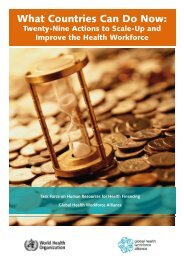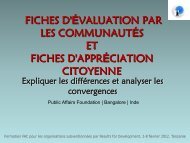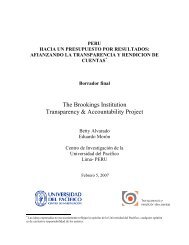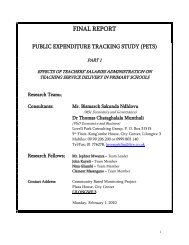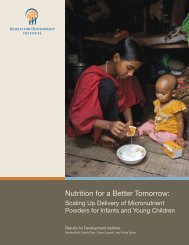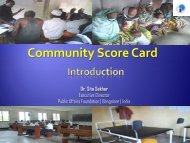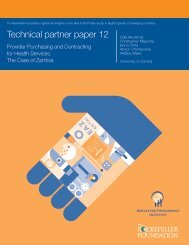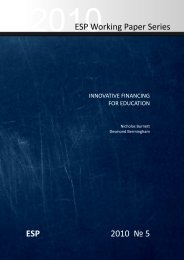Innovative Secondary Education For Skills Enhancement
Innovative Secondary Education For Skills Enhancement
Innovative Secondary Education For Skills Enhancement
Create successful ePaper yourself
Turn your PDF publications into a flip-book with our unique Google optimized e-Paper software.
Introduction<br />
Background<br />
In most low- and middle-income countries (LMICs), the<br />
four-decade rapid growth in youth population is ending<br />
and a period of stability is starting. This has important<br />
implications for the economic and education futures of<br />
all countries, and provides LMICs with an opportunity to<br />
deliver secondary education to most of their population.<br />
The exception is in Sub-Saharan Africa, where the number<br />
of young people is projected to continue to rise to 391<br />
million by 2050 and could reach more than 500 million by<br />
2100 (Mason 2012). This poses a huge challenge to African<br />
countries—to educate and provide decent work opportunities<br />
for this growing youth population. But it also offers a<br />
significant opportunity—as it will be the only major region<br />
in the world with a growing and youthful workforce.<br />
One of the keys to unlocking this opportunity, and to<br />
ensuring that all LMICs are able to harness the potential of<br />
the youth workforce, will be providing good-quality education<br />
and training for young people so that they acquire<br />
the skills and knowledge they need to thrive in the local,<br />
regional, and global economies. Because most workers enter<br />
the workforce straight from secondary-level education,<br />
it is that level that should be strengthened to ensure that<br />
students are receiving the best possible tools for success.<br />
While most developing countries have succeeded in establishing<br />
compulsory basic education laws, the acquisition<br />
of some level of upper secondary schooling is increasingly<br />
regarded as the distinguishing factor for young people<br />
seeking jobs in the formal economy in either the private<br />
or the public sector. Indeed, a review of the literature on<br />
the economic benefits of education as a whole shows a<br />
clear correlation between increased levels of educational<br />
achievement, higher individual earnings, and stronger<br />
economic growth (Guison-Dowdy 2012). A paper commissioned<br />
for this study found that higher levels of skills<br />
and knowledge have also brought benefits to individuals<br />
working in the informal economy (Pina and Kotin 2012).<br />
The higher-level thinking skills and communication<br />
competencies that are developed in secondary schools and<br />
beyond appear to bring higher returns than basic literacy<br />
and numeracy skills instilled in primary schools (Guison-<br />
Dowdy 2012).<br />
This increased demand for post-basic education has led<br />
to a significant increase in the number of young people<br />
enrolled in secondary school education in all regions of<br />
the world. Globally, more than 500 million youth were<br />
enrolled in secondary schools in 2009 compared with<br />
196 million in 1970. However, while gross enrollment<br />
rates have risen significantly, the quality and relevance of<br />
secondary education curricula and delivery are not keeping<br />
pace with demand, in particular with regard to the<br />
ability to prepare youth for demands of the workforce.<br />
In particular, the complementary ISESE synthesis paper<br />
on skills for employability (hereafter referred to as “skills<br />
synthesis”) illustrates that non-cognitive or “life” skills<br />
are significantly lacking in current traditional secondary<br />
school curricula.<br />
There is extensive research evidence to confirm the value<br />
of secondary education both to the individual and to<br />
society in terms of economic benefits and improved health<br />
outcomes (especially for young women), as well as helping<br />
to establish more stable and open societies. There is<br />
also evidence to show that at the household level, parents<br />
are willing to make sacrifices to secure the benefits that<br />
secondary education provides for their children.<br />
However, while many LMICs have raised secondary<br />
education as a priority, the explicit link between secondary<br />
education and skills for employment is still absent in<br />
many national education systems. The lack of preparation<br />
for employment at this level is a problem given that most<br />
youth entering the workforce will not obtain any education<br />
beyond the secondary level.<br />
The biggest challenge for most countries is the lack of<br />
financial and human resources—especially trained and<br />
qualified teachers—to respond to the growing demand for<br />
secondary education and effective skills training. It will<br />
not be possible to provide a good-quality education for<br />
the majority of young people in developing countries if<br />
they continue to rely on traditional models of secondary<br />
schooling and skills training. Unit costs are high; trained<br />
and qualified teachers are scarce; and resources are wasted<br />
in inefficient schools with small class sizes and out-of-date<br />
education materials.<br />
There is an urgent need to find innovative models to<br />
deliver high-quality secondary education to students to<br />
ensure that young people are given the skills and knowledge<br />
they need to thrive in the local, regional, and global<br />
economies. This paper identifies some of these successful<br />
models, and begins to consider how they might be scaled<br />
up or replicated across different contexts.<br />
36 <strong>Innovative</strong> <strong>Secondary</strong> <strong>Education</strong> <strong>For</strong> <strong>Skills</strong> <strong>Enhancement</strong> (ISESE)



